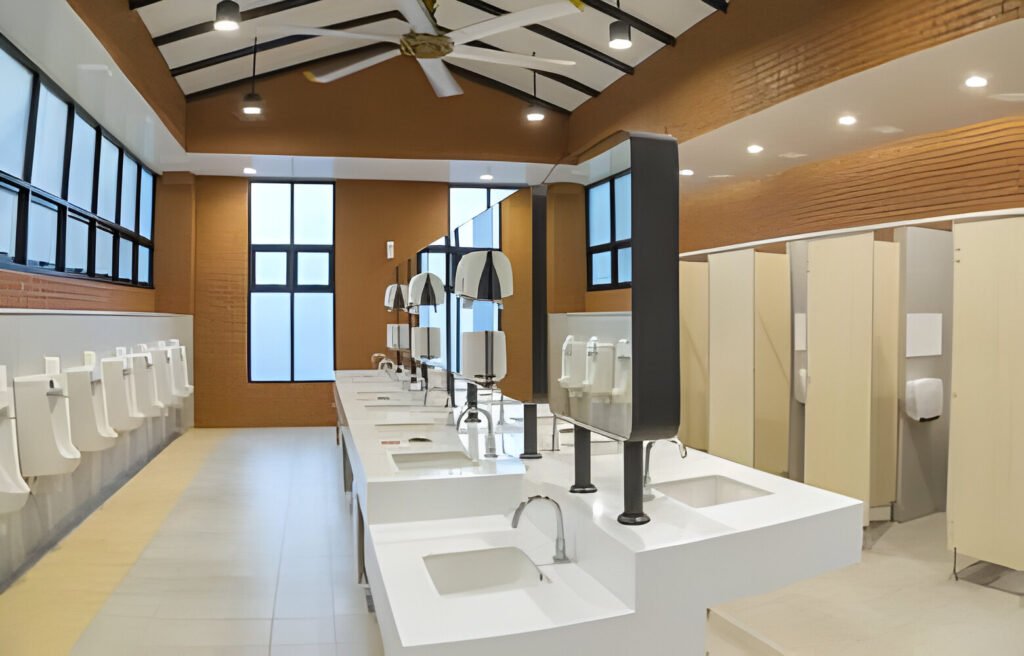It’s common to use paper towels to wipe your hands in a public place whether it’s a hotel, mall, or restaurant. We usually do not think about this habit when using a restroom. But this practice may expose your hands to germs and bacteria while reaching for the tissue dispenser. Not just that, paper towels come at a cost to the environment, make cleaning a mess, and amount to a large expense for your business.
Commercial places like factories, offices, and restaurants should encourage the use of electric hand dryer to maintain hygiene on premises. A hand dryer is an undeniably essential equipment in a washroom, especially after the covid-19 pandemic. It prevents the transmission of disease-causing germs spread through touch while using a public bathroom. A hand dryer is designed to be mounted on walls easily, once installed it barely requires any maintenance & cleaning. In this blog, we will explain how do hand dryers work and learn more about the types of bathroom hand dryer available in the Indian market.
How do Hand Dryers Work?
Hand dryers are automatic electrical appliances with a sensor that detects the motion of your hands when invisible infrared light bounces back. The motor detects this electric signal from the sensor and gives power to the fan that blows air over a heated element through a wide nozzle. This produces hot air that helps evaporate the water off of your palms. Hand dryers draw air from the environment, usually, they are equipped with a High Efficiency Particulate Air (HEPA) filter that acts as a bait for bacteria and contaminants. This in turn only allows the flow of fresh air through the nozzle onto wet hands.
Types of Bathroom Hand Dryer
1. Hands-In Auto Hand Dryer
A hands-in dryer may appear intimidating to first-time users. But it is the most simplified version of a traditional push-button hand dryer. You have to insert and hold your hands in the space provided, the dryer will blast air pressure from both sides of the device. This will dry your hands without needing to turn your hands to the other side. Nothing could be more convenient than drying your hands in just a flash of 7-10 seconds. This hand dryer is also designed with a hot or cold air option that allows you to dry your hands comfortably. With a stainless steel matt finish, this dryer makes your restroom look like a modern hotel room.
2. Hands-Under Warm Air Dryer
Hands-under air dryer is a much friendlier yet noisy version of the technologically advanced hands-in dryer. To dry your hands hold your palms facing up under the dryer. The heat from the warm air will evaporate the water from the other side of your wet hands. To dry out your hands completely, you will have to turn your palms upside down. This dryer generally takes less than 30 seconds of hand dry time depending on the motor power, which can get annoying sometimes if the property traffic gets high at times. This hand dryer uses MRF Vapocure technology that increases its durability which will prove cost-effective for the business in the long run.
3. Mini Jet Hand Dryer
This mini jet hand dryer could be used in spaces like offices and restaurants with high volume everyday footfall. It’s equipped with a contactless sensor for activation and dries your hands in just a span of 12 to 15 seconds. Unlike a hot air dryer, this one blasts a combination of hot and cold air that dries your hands in no time and even protects your skin from irritation. Designed keeping efficiency in mind, it shuts down automatically after continuous usage of 30 seconds. The mini structure makes it a perfect fit for washrooms that are small in size but end up getting a high volume of traffic every day.
4. Nozzle Style Hand Dryer
Old nozzle-style steel hand dryer is usually seen in public restrooms and similar facilities. Made with a stainless steel cabinet material that gives this hand dryer a robust structure and a sleek look. Place your hands under the nozzle to automatically dry your hands with a blast of warm air in 18 seconds. Not only it’s hygienic and stylish, but it’s also not going to burn a hole in your pocket.
5. High-Speed Hand Dryer
With an air speed of 35 m/s, this hand dryer blasts high-speed warm air on your hands once the sensor detects the motion of your hands under the device. In less than 15 seconds, it evaporates all the water droplets from your hands. Drying your hands with a warm air hand dryer is not only quick but also hygienic. It kills germs and bacteria that could be the cause of infection, especially in public places like restrooms and restaurants. This high-speed hand dryer is suitable for medium-volume traffic places like cafe shops, eateries, and clothing stores.
For every need and use, you can find an exact match hand-dryer that will be affordable and turn out to be beneficial for your business. Before buying a hand dryer, one must consider factors like cost, noise, power, speed, and durability of the device. Some hand dryers are also fitted with air purifiers that increase their functionality and purpose in a public washroom. If you are aware of your budget and needs, it’s not going to be a tricky affair. Even if you want to explore any brands online, be aware of your requirements beforehand. It would be smart of you, if you read about the mechanism of how do hand dryers work. If you are well-informed of it’s working, you will be able to choose the best type of hand dryer for yourself or your business.







